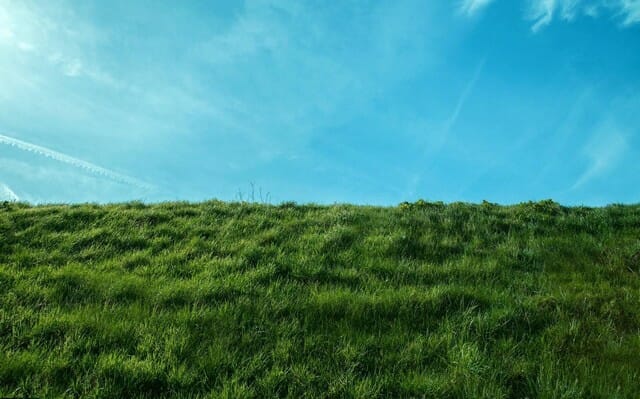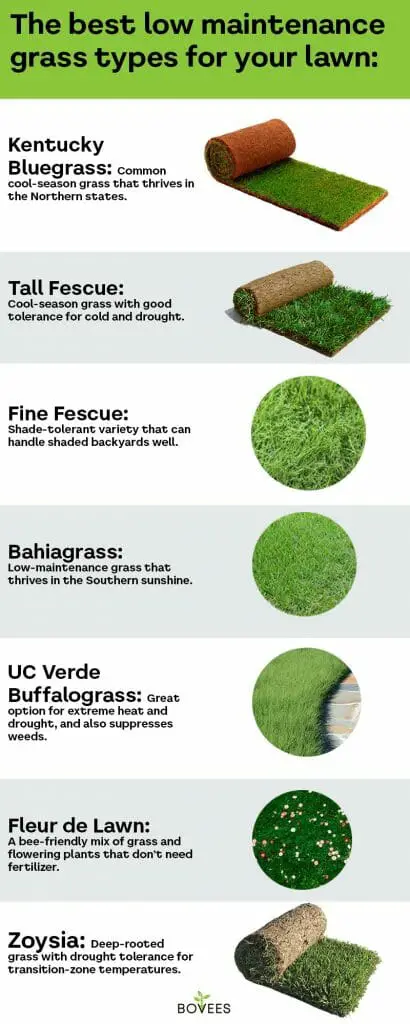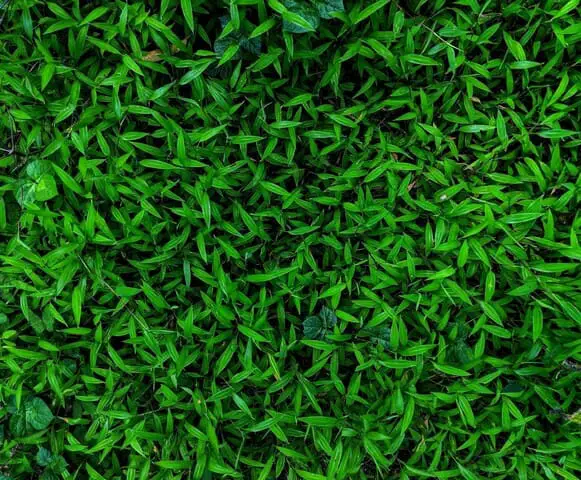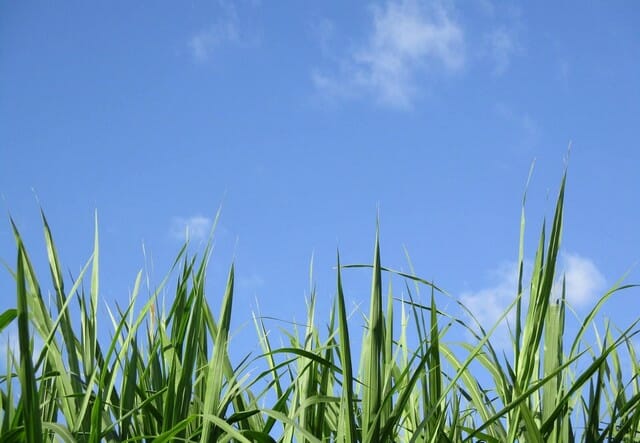Last Updated on April 18, 2022 by Grow with Bovees

Lawn care and maintenance of ornamental grass types — such as St. Augustine grass or Bermuda grass, which is often used for golf courses — takes time and effort, but you might not have much of it if you have a family, due to heavy foot traffic caused by pets or children playing on the grass.
This means all of your maintenance efforts to keep a healthy lush lawn, will be for nothing.
So, what would be the solution to this problem? Enter and get to know the best low-maintenance lawns instead of wasting your time on a more traditional lawn.
We’ll walk you through everything you need to know on low-maintenance grasses, including the best types for every climate.
If you want to get straight to it, these are my favorite types of lawns that require less maintenance:
- Kentucky Bluegrass.
- Tall Fescue.
- Fine Fescue — chewing fescue, creeping red fescue, hard fescue, sheep fescue.
- Bahiagrass.
- UC Verde Buffalograss.
- Fleur de Lawn — perennial ryegrass.
- Zoysia grass.

Best Practices To Get a Low-Maintenance Lawn
Whichever low-maintenance grass type you pick, you’ll put in less work if you follow these best tips for taking care of your lawn.
Tip 1: Water Wisely
You don’t have to water your lawn every day, just water it enough to maintain moist soil!
Spacing out watering will save you time and grow your lawn stronger, meaning you won’t have to waste time fertilizing constantly.
Try to space it out and do a thorough watering about once a week. You can water your lawn more often in extremely hot weather or if it receives big amounts of sun exposure, but only if the grass looks dry.
It’s also key for keeping clay soils from caking in the upper layers. In contrast to clay soils, sandy soil and silt soils with higher porosity can handle more frequent watering, but you should still avoid doing it every day.
Tip 2: Fertilize for Growth
When you apply fertilizer to your lawn, make sure you’re doing it at the right moment to take advantage of your turf’s primary growth season. This way, you can help your grass stay green for longer.
Try to use a natural fertilizer rather than a chemical one and avoid fertilizing in full sun exposure, this way you will have more erosion control resulting in less amounts of damaged grass or lawn diseases.
If you have poor soil in your garden, fertilize it before planting grass seeds in order to restore the nutrients that are not present.
Cool Season Grass
Cool-season grasses have fine blades that are soft under your feet, making them a good option for families that spend a lot of time on the grass.
They do most of their growing in the early spring and fall. They don’t go fully dormant in the winter and can turn brown in the summer.
They need more help for growth right at the beginning of the spring, as soon as temperatures are consistently over 70 degrees Fahrenheit (21.11 °C).
You can fertilize again in the fall, but there’s no need to do it across the summer unless your lawn is really in need of nutrients.
Warm Season Grass
On the other hand, warm-season grasses are quite heat tolerant and grow most in full sun exposure, during the hottest summer days of June, July and August, and go dormant in the cold winters.
Warm season lawns benefit most from fertilization in summer when they’re actively growing.
You shouldn’t fertilize them too early in the spring but rather wait for the grass to actively grow. Too late in the fall can also weaken the roots during the winter, so stick to fertilizing across the hot summer months to maintain a beautiful lawn.
Tip 3: Keep it Long
Don’t cut your grass too short. When the blades are bigger and longer, the plants have more room for photosynthesis, and they grow stronger roots. This, in turn, will help you grow a more resistant, maintenance-free grass.
As a general rule, chop about a third of the blades when you mow and aim to always leave them at a minimum length of 3 to 4 inches. Less mowing is always better.
Tip 4: Leave the Clippings
Leave the grass clippings on the lawn when you’ve mowed it. They’re full of essential nutrients for your grass, so leaving them in both acts as a natural fertilizer and takes one additional job from your hands.
Tip 5: Correct Soil
Grass seed likes to grow in soil that is well-draining but it should also be able to retain some amounts of water. Sandy soil is the fastest draining soil type, whereas clay soils have the ability to retain water.
So, what happens if you put clay soil and sand together? You get the best of both worlds. Add some silt — which is a type of soil that has smaller particles than sand grains and is also fast-draining — to the mixture and you get what is known as loam soil, which is considered to be the best soil for grass seed to grow in.
Another soil property that is important to know when wanting to plant grass seed or maintaining an already established lawn, is the pH level of the soil. Are you dealing with an alkaline soil or an acidic soil?
Neutral or slightly acidic soil is the best when it comes to growing grass seed. Too alkaline or too acidic, and nutrients are unable to be absorbed.
Make sure that the soil contains enough vital nutrients for the grass seed to develop beautiful green grass blades, resistance to diseases and strong roots.
Amend nutrient deficient soil with organic material such as grass clippings, dead leaves or compost.
The retention of water can be improved by simply adding some coconut coir, peat moss or vermiculite.
How to Pick the Best Low-Maintenance Grass for Your Lawn
You can find low-maintenance lawn grass seed for all climates. Whether it be grass seed for areas of full sun, partial shade or full shade, you need to make sure you’ve picked the right one for your location based on the below factors.
Heat
Cool-season grasses, like Kentucky bluegrass and tall fescue — among other grasses — thrive in cooler climates and have a high shade tolerance. They do not like full sun.
Cool season grasses are not good for the Southern US states’ extreme summer heat but are better suited for the Northeast and Northwest.
Some, like tall fescue, also work well in the transition zone that reaches through the Midwest and across the country. This zone is where the subtropical and temperate climates mix, so maintaining your lawn can be more challenging.
Warm-season grasses — or Southern lawns — like zoysia grass, usually have great heat tolerance and have some drought resistance; they thrive best in warm climates, which is why they’re common in the South.
Sun and Shade
Be sure to analyze which parts of your lawn get how much sun and shade throughout the year for optimum or less maintenance.
Some types of grass, such as Kentucky bluegrass, can’t survive in the shady areas. Others, like fescue, thrive on completely shady areas. And then you have the grass seed types that thrive in areas of partial shade and full sun.
You can also use grass seed in batches, with different types for different areas of your lawn if they vary in sun and shade levels.
Water
If you live in a place with little rainfall in the summer, pick a variety that is highly drought resistant like the UC Verde buffalo grass, which has a deep root system. This will help the grass drain more moisture from the ground and survive with less water.
For areas with heavy rainfall, choose grass seed that can handle the extra moisture. Avoid varieties such as fescue that suffer from too much moisture.

Our Recommended Low-Maintenance Grasses
These are our favorites for home gardeners, from cool-season varieties to transition-zone and warm season grasses that are naturally resistant to heat.
Cool Season Grasses
Let us start off with the native grasses of cooler areas of the world.
Kentucky Bluegrass
Kentucky bluegrass is a common cool-season grass in the Northeast and on the West Coast. It thrives in direct sunshine and isn’t ideal for shaded lawns but becomes dormant in droughts, recovering quickly through watering and keeping the soil moist.
It’s also tough enough to survive winters, but its root system is shallow. This means it will benefit further from the above lawn maintenance tips for stronger roots.
Tall Fescue
Tall fescue is a cool-season grass with deep grass roots that make it more drought resistant. It’s one of the most common options for the tough transition zone between climates because it has good resistance to both the cold and heat.
The grass seed adapts well to different soil types, and it doesn’t require much fertilizing, thanks to its deep roots.
This turf type is generally low-maintenance and grows best when you water it deeply and not too often. If it gets too damaged from extreme heat or foot traffic, though, it doesn’t bounce back easily.
Fine Fescue
Fine Fescue grass doesn’t require a lot of fertilizer or sunshine, making it excellent for a low-maintenance lawn that can survive in shaded backyards. It’s one of the best slow-growing grass types for those who hate mowing.
It also grows best in cool climates that aren’t too wet. In high heat, this grass variety tends to thatch—gathering debris from roots, dried stems and shoots, making your lawn look brown and requiring lots of maintenance to fix the issue.
Fine fescue also doesn’t recover fast if it gets damaged because of high temperatures.
Warm Season Grasses
Bahiagrass
Bahiagrass is most common in the Gulf Coast region and across the South. This is because it thrives in full sunshine and heat and doesn’t require a lot of water or fertilization. This makes it ideal for those looking for a low-maintenance lawn option for warm weather.
UC Verde Buffalograss
The UC Verde is a drought-tolerant warm-season grass that survives well in the heated and dry conditions of the US South.
It’s a modernized, improved version of Buffalograss native to the United States and Mexico, so it’s naturally apt for these climates.
UC Verde Buffalograss is also low-maintenance because it suppresses weed growth well, so you’ll spend less time getting rid of those nasty weeds.
Fleur de Lawn
Fleur de lawn is a flowering grass mix that’s great for its low maintenance and eco-friendliness.
Scientists at Oregon State University developed this mix, making it suitable for the Northeast weather and good for pollinating insects, such as bees.
This type of lawn includes perennial ryegrass, hard fescue, clover and daisy, among other grass types. This mix is designed to bring back nutrients to your lawn to make it more low-maintenance.
Clover, for example, restores nitrogen, so you won’t need to fertilize as much.
You can use fleur de lawn on your entire lawn, but most people choose it for spots and ground cover where they want to have flowers, not only green grass. Just remember that it doesn’t thrive in the shade!
Zoysia
Zoysia is a drought-tolerant, warm-season grass that grows mostly through the late spring and summer.
It tends to push roots deep in the ground, helping it take moisture from the ground in dry conditions, meaning you’ll need to water it less frequently.
You can plant zoysia grass in the hot US South, where freezing winters don’t exist. But, it also works well as a transition-zone grass in states from the Midwest to the Pacific.

Pick the Ideal Grass for Your Lawn’s Needs
Don’t go for a grass type merely for its blade type or color, especially not if you are dealing with heavy foot traffic! Yeah, sure Bermuda grass or St. Augustine grass is nice, but is it worth it?
Instead, if you want a low-maintenance lawn, you’ll do best with the grass seed type that goes well with your local climate and backyard. If you want really low maintenance, then you can always opt for a lawn alternative.
When you’ve applied your low-maintenance grass seed, be smart about your lawn care. Water and mow less frequently, leave grass clippings in and reserve fertilizing for the best growing season.
